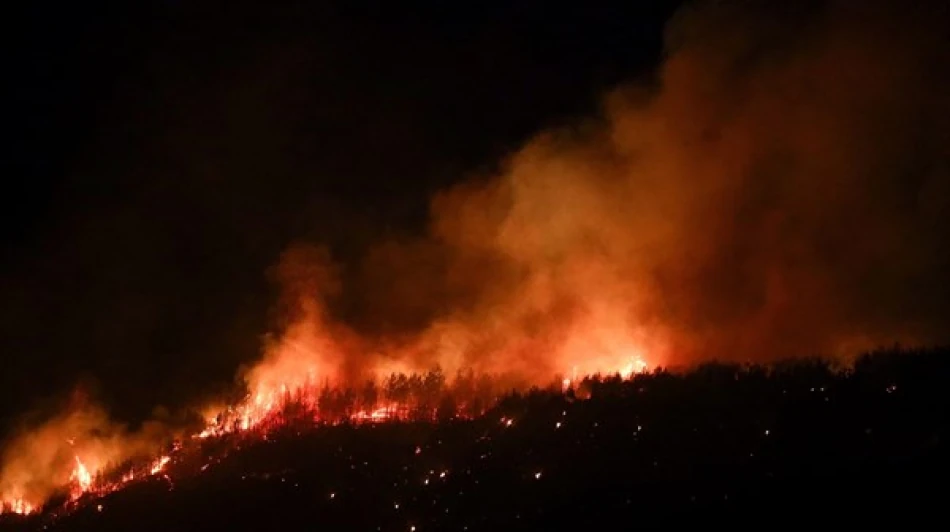
Europe Gripped by Scorching Heatwaves and Raging Wildfires
Europe Burns: Climate-Driven Wildfires Signal a New Era of Extreme Weather
Europe is experiencing a devastating convergence of extreme heat and wildfires that underscores how climate change is reshaping the continent's weather patterns. As temperatures soar toward 44°C in southern regions and fires rage from Spain to the Balkans, the crisis represents more than seasonal weather—it's a preview of Europe's climate future that demands immediate adaptation strategies.
Spain Bears the Brunt of Fire Season
The human cost became tragically clear when a man died overnight in a fire that consumed over 1,000 hectares near Tres Cantos, just 25 kilometers north of Madrid. The victim suffered burns across 90% of his body, highlighting the lethal intensity of these blazes.
"We are at severe risk from forest fires," Spanish Prime Minister Pedro Sánchez warned on social media, as thousands of residents spent the night away from their homes due to emergency evacuations.
In southern Spain's Andalusia region, authorities narrowly averted disaster when flames reached residential areas near the tourist destination of Tarifa. Regional Interior Minister Antonio Sanz described "moments of extreme danger" as emergency crews conducted evacuations "in record time."
UNESCO Sites Under Threat
The fires aren't just threatening homes—they're endangering cultural heritage. Around 600 people evacuated from villages near the UNESCO World Heritage site of Las Médulas in Castile and León were allowed to return Tuesday morning, though multiple fires continue burning in the surrounding area near Zamora.
A Continental Crisis Unfolds
France has declared maximum heat alerts across 14 departments in the southwest and east-central regions, while Italy imposed its highest warning level in 11 major cities including Rome, Milan, and Turin. Even typically cooler northern regions are feeling the impact.
Portugal battles three active fires, with 700 firefighters and four aircraft working to contain the Trancoso blaze that has burned since Saturday. Authorities fear the worst is yet to come as temperatures climb toward dangerous peaks.
The Science Behind the Suffering
Meteorologist Akshay Deoras from the University of Reading explains that this isn't unexpected: "The heatwave currently affecting France, Spain, and the Balkans is caused by a stable thermal dome over Europe. Due to climate change, we now live in a notably warmer world, increasing both the frequency and intensity of heatwaves."
The expert points to a critical factor: drought conditions affecting more than half of Europe, particularly around the Mediterranean basin for several months, creating ideal conditions for fire ignition and spread.
Historical Context Reveals Alarming Trends
Britain's Environment Agency raised particular concern about water shortages in England, now classified as "a matter of national importance." The first half of 2024 marks the driest period since 1976—a year remembered for severe European drought—suggesting a troubling pattern that threatens the entire continent.
Southeastern Europe: The Forgotten Frontline
The Balkans present perhaps the most concerning picture. Albania continues fighting 14 active fire zones, while Montenegro and Croatia battle their own blazes. Kosovo recorded its highest-ever temperature in July at 42.4°C, a milestone that would have been unthinkable just decades ago.
These southeastern European nations, with limited firefighting resources compared to wealthier western neighbors, face disproportionate challenges in adapting to this new reality.
Economic and Strategic Implications
This crisis carries profound implications beyond immediate human suffering. Tourism-dependent regions like Andalusia face potential long-term damage to their economic foundations. Agricultural zones experiencing repeated drought and fire cycles may become economically unviable, forcing demographic shifts that could reshape European population patterns.
The strain on emergency services, healthcare systems, and insurance markets will likely accelerate calls for coordinated EU-wide climate adaptation funding—a conversation that's moving from academic circles to urgent policy necessity.
A Glimpse of Europe's Climate Future
What's unfolding across Europe this week isn't an anomaly—it's adaptation in real-time to a climate that has already changed. The combination of record-breaking temperatures, prolonged drought, and intense wildfires represents the new baseline rather than an exceptional event.
European policymakers face a stark choice: invest heavily in climate resilience infrastructure now, or continue responding to increasingly frequent and severe crises with emergency measures. The fires burning from Spain to Albania suggest that reactive approaches are no longer sufficient for a continent entering uncharted climatic territory.
Most Viewed News

 Layla Al Mansoori
Layla Al Mansoori






